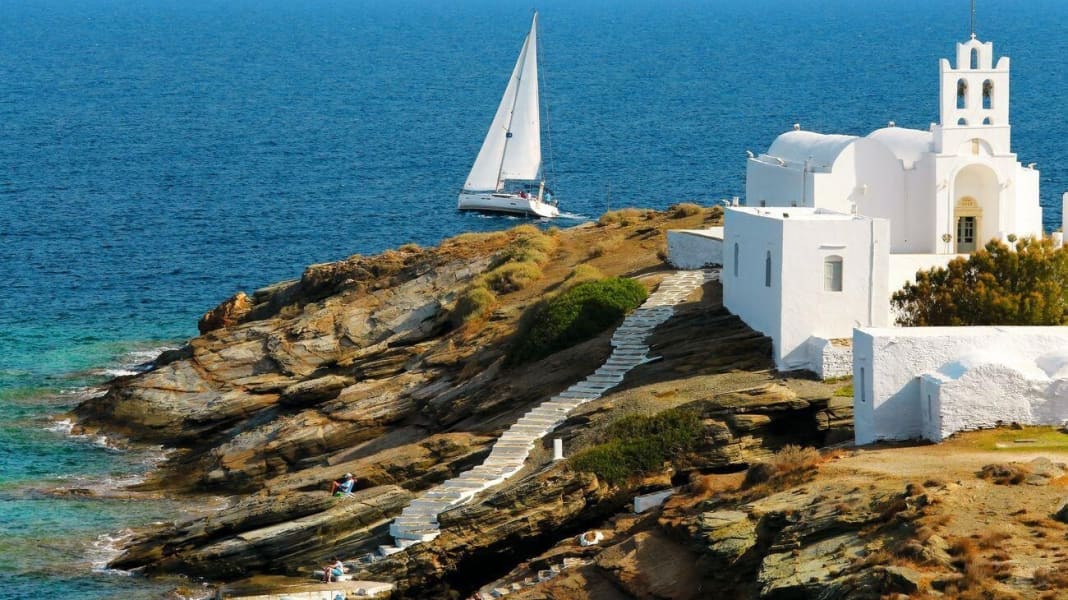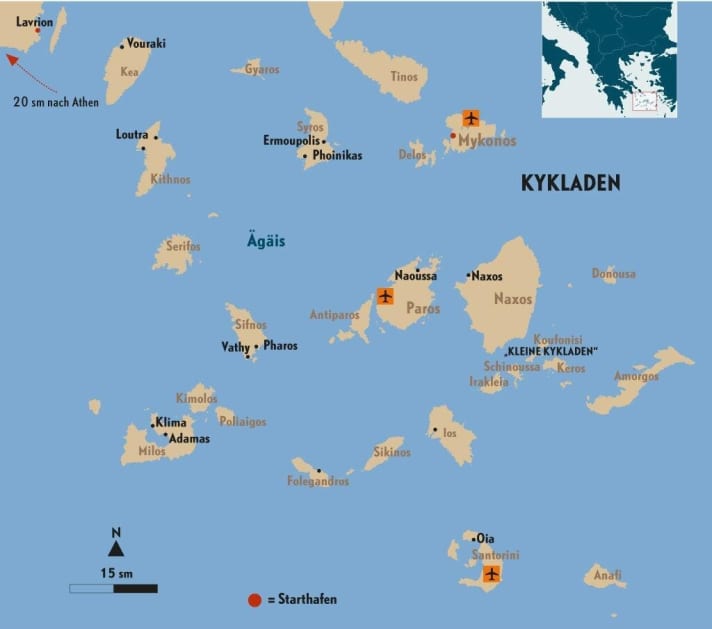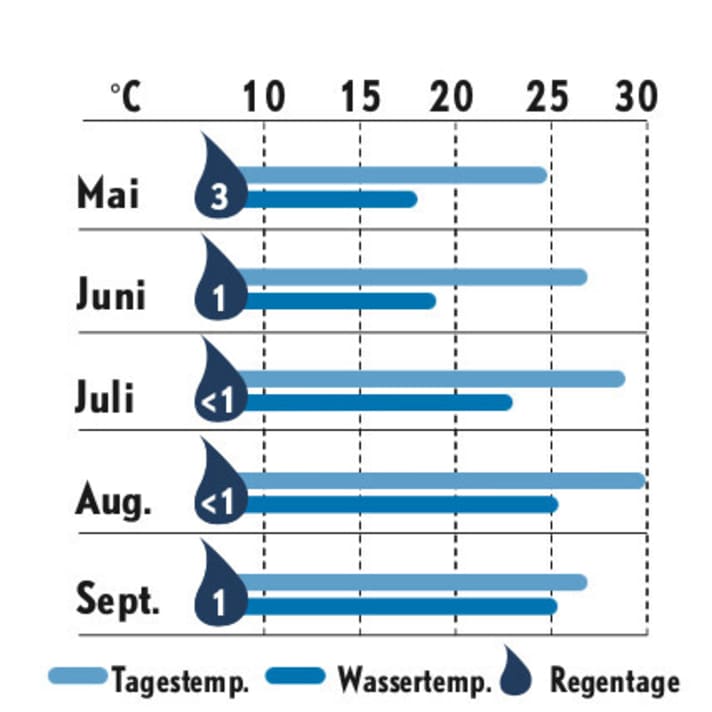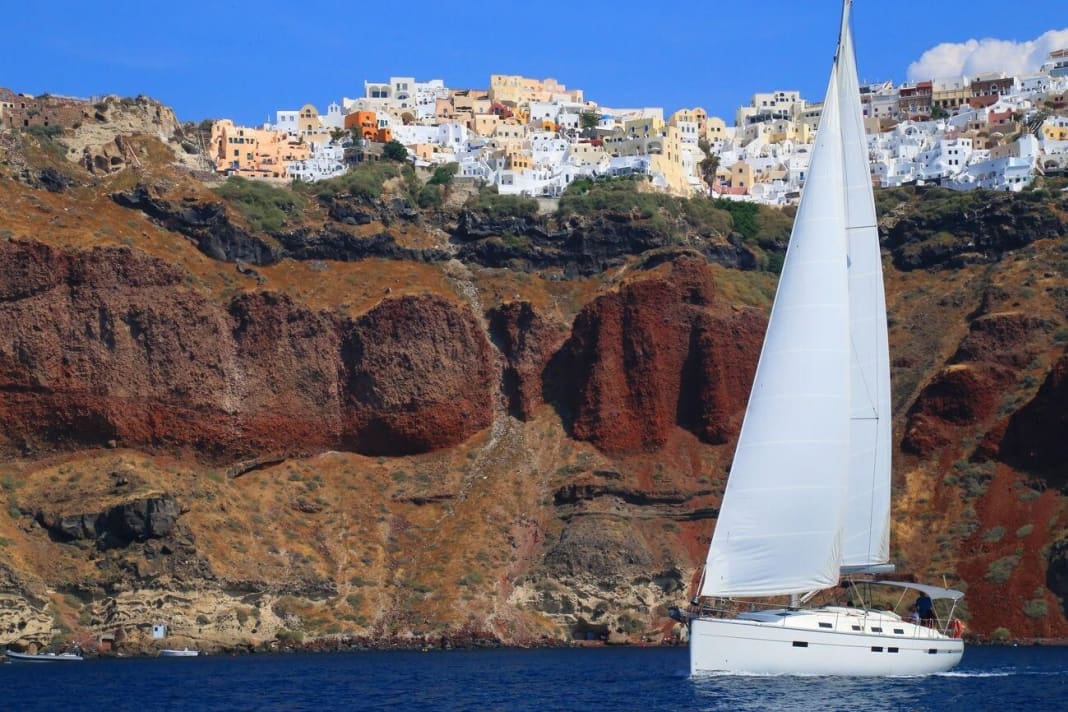

CHARTERStart usually fromAthens orLavrion. The range of charter fleets there is huge. In many cases, small transfer bases on other islands such asParos, Mykonos or Syros,But getting there is usually complicated. There are practically no direct flights, you have to change planes in Athens or take the ferry, which takes a long time or is only possible the next day.Oneways are feasible, for example to Kos (Dodecanese) or Paros, but relatively expensive (approx. 500 to 750 euros surcharge). For two-week trips, however, the fleet operators are often able to find a solution, especially if the ship is not returned far to the south. Such return trips are often cheaper - but they go from south to north against the prevailing wind.
ARRIVALFlights to Athens from many German airports, prices from approx. 300 euros. Transfer to Athens or Lavrion approx. 30-40 minutes by taxi. Many of the islands can only be reached with a transfer in Athens, the flight does not always leave on the same day!

WIND & WEATHERFrom June, theMeltemi It reaches its greatest strength in July and August and then subsides again by the end of September. It blows at approx.80 per cent from the north-eastin the northern Cyclades and the south-west, in the centre more from the north. As it is fed by the large, stable heat low over the Turkish mainland and a high in the western Mediterranean, it is very stable from June to September. Meltemi usually blows with 5 to 6 Beaufort, but sometimes it can be much stronger and can last for days, even with 8 to 9 force winds. Old rule of thumb: If you sail south during the Meltemi period, you should plan two thirds of your sailing time for the return journey! In other words, first take long southerly courses, then shorter ones on the way back, as they are often upwind courses.
Beware ofNozzle and chapel effectsBetween the islands, the wind sometimes increases by one to two wind forces, there are also downwind gusts, as a number of the Cyclades islands are relatively mountainous. Such effects also bring significant wind shifts. Some important Meltemi jets are marked on the map. Clever, foresighted reefing is important there. In the early and late season, there is either a lighter northerly wind or a southerly sea breeze. As a storm, theSciroccofrom the south, especially in the early and late season.
Good weather and swell forecasts can be found on the website of the Greek weather servicePoseidon (www.poseidon.hcmr.gr) and the usual sources such asWindy (www.windy.com) orWindfinder (www.windfinder.de) and its iOS and Android apps.
HANDLES & ANCHORSMostly simpleMunicipal harbours with piers where you can moor in front of bow anchors, sometimes alongside in the low season. Electricity and water are often available, the latter partly by tanker, as is diesel. There are often no or only basic sanitary facilities. Help from marineros when mooring is not a matter of course. Mooring is either with a bow anchor and stern to the pier or sometimes with mooring lines. Sometimes harbour dues are charged, sometimes not, but Greece is very cheap, with a 43-foot boat costing around 15 to 30 euros. There are many beautiful, well-protected anchor bays, some secluded, others with a bar and taverna on the beach. The choice is huge, and apart from a few hot spots, there is almost always enough space and often enough even secluded spots! Shore lines are rarely laid out, as shallow water and a good holding bottom are not uncommon. No paid buoy fields.






NAVIGATION & SEAFARINGMeltemi and squalls can make harbour manoeuvres and anchoring challenging.
challenging. Good planning is then the recipe for success. Always put in plenty of chain and weigh the anchor thoroughly and push hard in the harbour so that any meltemi phases or night-time squalls can be safely weathered. In some harbours, stones just off the jetty can endanger the rudder in swell.
Navigational the area is relatively easy, even if there are shallows that are not as well buoyed as in the western Mediterranean. In the harbours there is sometimes a mess at anchor when leaving the harbour if crews have laid the chains on top of each other. Tides are negligible, usually no more than 20 to 40 centimetres, with the exception of a lot of wind pressure and very shallow bays.
TheDistances between the islands are often larger, around 20 to 25 nautical miles; if the Meltemi lasts longer, the swell can be correspondingly high there. As a rule, however, the swell is relatively long due to the high water depths, not as short and steep as in the Adriatic or Baltic Sea, for example, and therefore easily manageable except in gale force winds.
CHARTS & LITERATURE
The best nautical charts are those from the Greek pleasure craft chart producer Eagle Ray and its British counterpart Imray. The former have very good harbour information and photos, while the latter are popular because of their clear and reliable charts. Cruising guide in German: Rod Heikell: Griechische Küsten, Edition Maritim. The English version is usually available on charter yachts.
TERRITORY CHARACTERISTICS
Hardly anywhere else in the Mediterranean are neighbouring islands so different and at the same time so attractive. Some rise steeply and ruggedly out of the sea. On their slopes or at the top of the mountain ridges sit ancient villages of typical whitewashed houses with blue doors and windows. Others are flat islets with idyllic bays and pretty fishing villages. Then there are the hip tourist hotspots such as Mykonos or Ios, notorious for their exuberant party and nightlife. No less popular is Santorini with its spectacular old town on the slope of an ancient, crescent-shaped volcanic crater. What almost all the islands have in common is that they are barren and rocky; the dry, constant summer wind Meltemi has been literally drying out the islands for centuries.
There are also many smaller and mostly lesser-known islands whose picturesque harbour towns are also worth a visit: Naoussa on Paros, Ermoupolis on Syros or Kamares on Sifnos. Not to mention the many quiet bays, on whose shores there are usually a few small tavernas or a small village and where life is so wonderfully relaxed and simple. This is especially true of the small islands without an airport, such as Sifnos or Kythnos. Nowhere else is it easier to slow down than here.
It is true that the distances between the islands are greater than in the neighbouring Dodecanese or even the Ionian Sea. The distance is often around 20 to 25 nautical miles. However, this is not a problem as there is almost always a good wind for sailing. In the early and low season, when there is usually a moderate wind of three to four forces or even thermals prevail, the Cyclades are a dream area even for crews who are not in the mood for a strong wind cruise. And in midsummer with its Meltemi, the rule of thumb is to plan two thirds of the charter time for the return journey. If you take this to heart, you won't run out of time even if you have to spend a day or two in harbour.
In general, crews who go sailing from mid-July to the end of August should be keen on sporty sailing and not shy away from a wet cross. After all, sailing on deep blue water and in long waves can be a lot of fun. Last but not least, there is something else in favour of the Cyclades: Mooring fees are far below the price level of Croatia, Italy or Mallorca. There are no bays with expensive mooring buoys. And restaurant visits often only cost 15 to 20 euros per head. In short, the area is by far the cheapest in the entire Mediterranean.
DETAILED YACHTING STORIES CYCLADES IN DOWNLOAD

